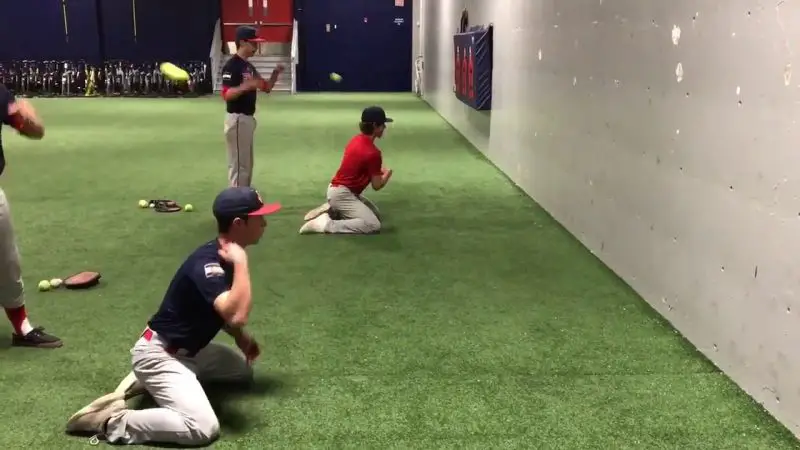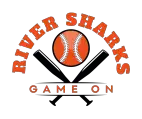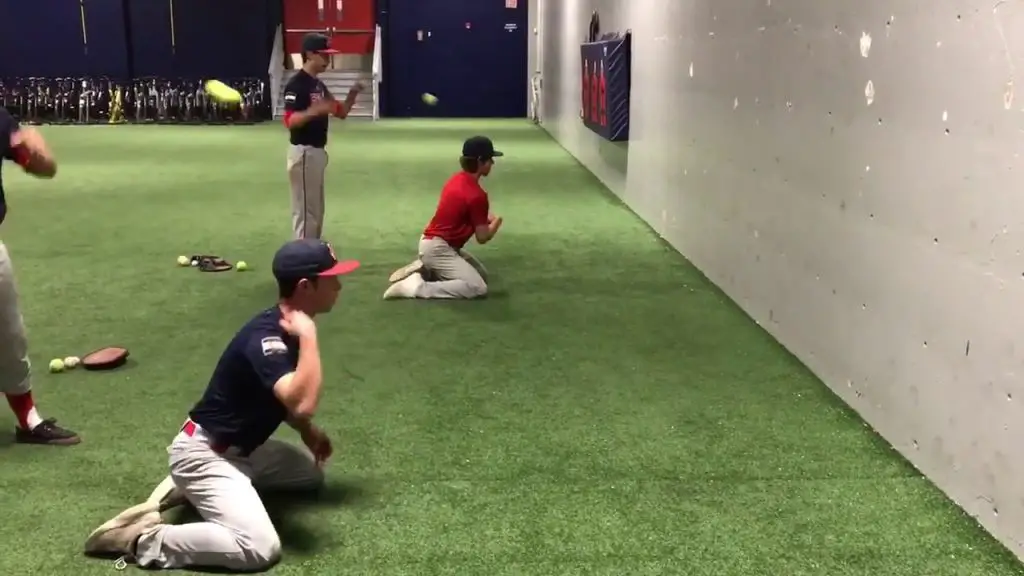Every sport requires practice, and baseball is no different. One might not have a baseball field at their disposal. However, it is good to know about the indoor outfield drills you can practice inside the closed doors.
Especially during the staunch seasons across the globe, it proves to be valuable for your health too. Although the minimum size of the house in which these drills can be performed is still debatable. But it is recommendable to improvise.

But the main advantage of these drills is that these can be pulled off even inside your own home or a closed space like a gym. Yes obviously if you have more space to use, the better it will be.
So, let’s get to it!
1. Tennis Ball Throw
This might be the easiest Indoor Outfield Drill of all. As the name suggests, this is the regular catch and throw with a twist. This requires minimum space and focuses on teaching a player to squeeze their mitts while catching.
The Focus
1. This would help you in coordinating your senses and reflexes and also adjust you to a squeezing mitt.
2. The drill would help you identify the weakness that you might have in handling the ball
Drill Setup and Practice
This Indoor Outfield Drill is quite simple. All you need are your mitts, a floor, and a tennis ball. It is performed in two primary ways. The first one is quite simple. All you have to do is toss the floor towards a nearby wall by tossing it diagonally and catching it once it bounces back towards you.
You have to do it repeatedly and catch it in your mitt every single time. The second way is more traditional but a bit unusual for a conventional catch and throw player.
You have to toss the ball towards the ceiling while being on the back facing upwards. This should be done wearing mitts. Do this repeatedly as long as you can. The more you do it, the more you will improve.
2. Toss Back Grounders
This is the kind of Indoor Outfield Drill that requires a black net. If you do not have a net, you can improvise and use a wall instead. Well, that is a luxury you can have while you try out these drills indoors. Although drywall is somewhat delicate, instead of using the traditional wooden ball, the use of a tennis ball is advisable.
The Focus
1. This drill is well-suited to make sure that the players can practice ground balls in action.
2. Repeated fielding of the ground balls routinely helps to improve the techniques associated with the same
Drill Setup and Practice
The baseball field version of this requires a group of people performing it together. Typically they form a semicircle with a person at the center. The center player throws ground balls at the other players in a random manner.
The Indoor Outfield Drill version of it is a bit different. Replacing the other players in the net/wall, one can put pieces of tapes signifying other players. Wearing a mitt, the player has to throw balls directly at the net/wall so that it comes back as a ground ball.
Importantly the net/wall should be at least 30 feet away. One has to do this rapidly; around 60 balls should be fielded. One can also throw balls at different angles, which can increase their awareness and concentration significantly.
3. Triangle Cone Drill
If you have trouble turning your body in a specific way to field a fly ball, then this is the perfect Indoor Outfield Drill for you. The drill is ideally suited to polish your lousy side in the baseball ground and help you be a complete player.
The Focus
1. Teach the players how to move smoothly to catch a fly ball
2. It helps you in finding the weaknesses that might be existent in the outfield fundamentals.
Drill Setup and Practice
The required apprentices for this drill are three cones, a ball, and a mitt. Not only for baseball, but it is also helpful for disciplines like hockey, football, etc. All you need to do is place the three cones in the shape of a triangle, hence the name "Triangle Cone Drill".
Place yourself (coach) and the player on different sides of the triangle. The key to this drill is to maintain enough reaction time to catch a fly ball perfectly. Try to throw it randomly at cones on either side of the player and then make them throw the ball back to you.
Make sure to make your decision about which side you're going to throw the ball unpredictable. It will help the opposing person to improve their reaction times drastically. This should be done in 4 rounds, and each player should get 60 seconds. Do this Indoor Outfield Drill regularly and notice your performance getting better noticeably.
4. Outfield Communication Drill
If you have your social circle a baseball freak like you, then this is the appropriate Indoor Outfield Drill for you. If you and your team have communication problems in the court, this drill is perfectly shaped for you.
Sometimes, lack of communication can result in numerous people trying to attempt that catch and still missing it. This surely can turntable in any critical match.
The Focus
1. Helps the outfielders communicate with each other with ease
2. It gives you a perfect understanding of when to call for the ball and when you are in the perfect position to do so.
Drill Setup and Practice
For this drill, you need to have 2-3 players and a ball. Make each of the players stand at equal distances forming a circle. After this is done, the coach is made to stand in the middle tossing the ball in the air.
After this is done, the players have to make a call on who is going to catch that ball. By throwing the ball into random directions, you can create real-life match-like situations too. Unlike other Indoor Outfield Drills, this drill depends upon the players as to how well it is performed.
5. The Zig-Zag Drill
If you have a hard time keeping your eyes on the ball, the 'zig-zag drill' is an appropriate Indoor outfield Drill for you. In baseball, if you lose the ball, you lose entirely. Thus, keep an eye on the ball and make sure it never misses your glance, and this drill will make sure that it is the case.
The Focus
1. Learn how to glue your eyes on a fast-moving ball
2. Learn the perfect way to drop step for fly fielding
3. It helps players refrain from backpedaling to a ball.
Drill Setup and Practice
To do this drill, a player should be at least 20 feet away from the coach. The coach holds the ball on top of the head. Then the ball is thrown in the opposite direction of where the player is running.
For example, if a player is initially pointing towards the left and has started the run, the ball is thrown on the right. This Indoor outfield Drill eliminated the lousy habit of back-stepping while fielding as that may increase the return throw time, which makes a huge difference.
Moreover, it is beneficial in training the players to keep an eye on the ball always.
6.Glove Foot Forward
The most overlooked Indoor Outfield Drill by the coach is the Glove Foot Forward. This may be a simple one, but it turns out to be quite valuable from time to time.
Catching a ball may be a simple thing; that is why it is easier to improvise and lose grip on the basics. This drill focuses on improving the skill of getting behind the ball and helps to make the transition from catching to throwing the ball in the infield. Being one of the most rudimentary parts of the game, mastering this only helps one in being a complete player.
The Focus
1. The fielders are wired to promptly get behind the ball every time to square up on the infield in case there is a catch.
2. Helps make the footwork better for the players when transforming from a catch to a throw.
Drill Setup and Practice
For this Indoor Outfield drill, the coach should stand 25 feet away from the player. When the ball is thrown towards the player, it has to be caught at the same time as the player lands on the glove side foot.
If this timing is perfected, then the player can transition easily. This will help you gain the skill of performing a quick catch and throwing it in the infield.
7. Outfield Relay Drill
This is one of the few Indoor Outfield Drill that required more space than the others. And by more, I mean it is best done in at least a basketball court. Even if you have space, it is best to perform with numerous athletes. So, when you are out with your whole team, be it indoors or outdoors; this is one of those drills that should be in your daily practice routine.
The Focus
1. Understand and analyze the proper time and footwork while in the baseball ground.
2. Helps in improving and improvising on the outfield throwing mechanics and its accuracy.
Drill Setup and Practice
Performing it is not complicated. All players are supposed to be on the far side of the gymnasium and line up. Then the ball should be thrown on the opposite side after crow hopping.
When the ball bounces back, the next player in line will run towards the ball to catch it and then throw it back at the wall. You have to continue this activity until everyone gets their turn. Although, if you want to prevent damaging the walls, the use of a pitch back net is recommendable.
8. Go Longs
The term "Go Long" is frequently heard in football. In that case, the player passes the ball considerably forward to the other one while running. As this Indoor Outfield Drill resembles that same action, it is less confusing why this too is called Go Long. This is one of those drills that would help the players warm-up, and thus, this can be one of those that you can regularly practice.
The Focus
1. It involves and improved hand-eye coordination while on the field. Catch the ball while running.
2. Help understand and point out the effective angles to the baseball when it is in the air.
Drill Setup and Practice
In this drill, the player and the coach run around each other to perform a football-like pass. The coach will then toss the ball up in the air at a random location. The key is to catch the ball while running. It is a popular pre-game warm-up.
9. Line Driver
A line drive may also be said to be "hit on a line", is when the ball is hit with the bat and flies off in a low arc trajectory. These kinds of catches are usually done while running towards the ball, which is natural as a ball with a lower arc might hit the ground before reaching where you are.
To improve these catches, the "line driver" is best. This is relatively quite easy and doesn't require an area of more than 20 yards.
The Focus
1. Help learn how to glue your eyes on the line drives and hop on it while on the move.
2. Improved your efficiency to track the ball.
Drill Setup and Practice
To perform this efficiently, the player and the coach are 15 feet apart with the coach on the right. The player should hit a sharp 90-degree right after running about 20 yards.
While running, the player should catch the laser thrown by the coach. This Indoor Outfield Drill improves one's ability to track the ball efficiently.
10. The Highlight Reel
There was a popular toy in the 2000s. It was a hardened plastic rubber ball known as the "crazy ball". It was a highly dense ball that used to bounce significantly more than a typical tennis ball.
In the early 2000s, it was a great pass time for many. This Indoor Outfield Drill is sort of that activity but a bit improvised. I will show you how and why.
The Focus
1. Help make the players aware of the field.
2. This drill helps improve the fielding efficiency of the players.
Drill Setup and Practice
The required equipment is a suitable wall, a baseball, and a mitt. The players are made to stand at random distances, generally, within a radius of around 15 feet.
Each of these players stands near a wall; the coach then throws the ball randomly at different players just short of the wall. The player's objective is to run towards the wall and catch that ball without bumping into the wall.
This helps increase the player's attention in the outfield. This drill is also an advantage as it increases outfield efficiency and can prove to be a deciding factor.
11. Fence Roller
Baseball is a unique sport as it challenges a player with numerous situations that requires all kinds of skills to encounter. As compared to a football field, a baseball field is considerably smaller; the attentiveness of a player is everything as it increases outfield efficiency. Practicing this drill, you would have a better fielding efficiency.
The Focus
1. Improves fielding efficiency on balls that are hit for the fence.
2. Polishes the techniques to throw back to the cut-off man.
Drill Setup and Practice
In this Indoor Outfield Drill, the player stands 15-25 feet away from the wall and ahead of the coach. Then the ball is thrown by the coach over the head of the player towards the wall so that it rolls towards it.
The task given to the player is that he has to run towards the wall, and when the ball bounces off the wall, he will have to catch the ball and throw it to the cut-off man.
This drill can be improvised to make it provide you with real-life situations. For example, you can play with some angles at which the ball is thrown so that it gives you a different ball to field.
Also, this drill is done with bare hands, which can be an addictive habit. This also helps players make responsible decisions. While you might need a considerable space for others, this drill can be done indoors.
12. Corner Wall Drill
While you can practice fielding all kinds of fly balls and even line drives in small spaces. You need a baseball gymnasium or similar enclosed spaces for improving the fielding efficiency of ground balls.
The Focus
1. While pursuing the ball, the players can gauge efficient angles with the help of this drill.
2. Helps improve the first step quickness
3. Sharpens the throwing techniques
4. Quickly locating the cut-off man.
Drill Setup and Practice
For this Indoor Outfield Drill, the coach and the players will have to consider the gym as a rectangle and stand on the adjacent vertices. The coach then rolls the ball on the diagonal side, the player then has to run and cut off that ground ball efficiently.
To improve skills for both sides, this can be performed in opposite directions too. If the player also throws the ball after cutting it off, you have a drill that can make you practice real-life situations comprehensively. These also help the player make his angles more efficient for fielding different kinds of ground balls.
Looking for more?
If you would like to read more, then we have hand picked some of our most popular pieces.
Drills:
11 High School Baseball Fielding Drills
8 Shortstop Drills to Build an Elite Shortstop
15 Best Ground Ball Drills For Your Next Practice
Equipment & Apparel:
Best Baseball Training Equipment
Best Baseball Bags
Best Baseball Sliders and Sliding Shorts

